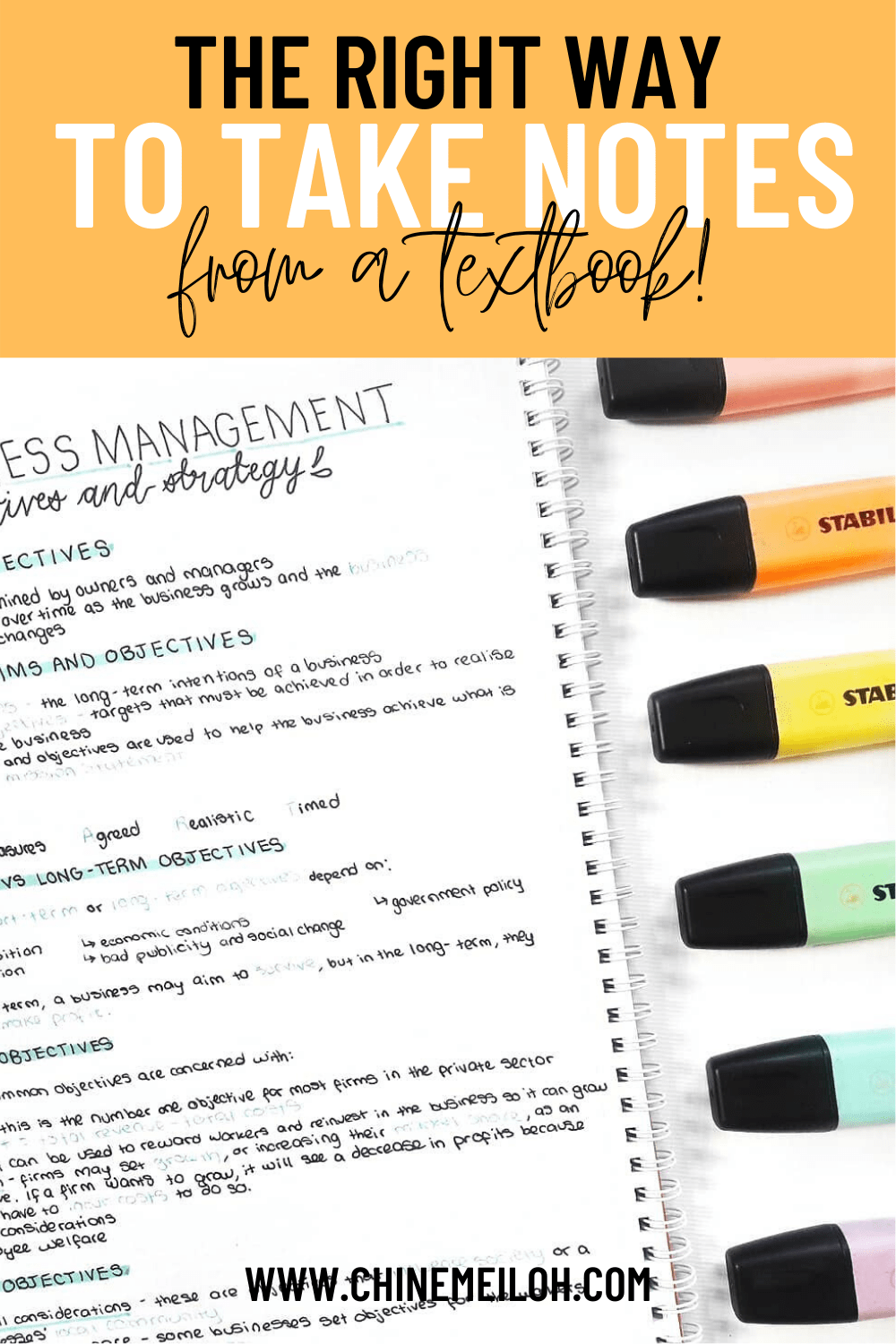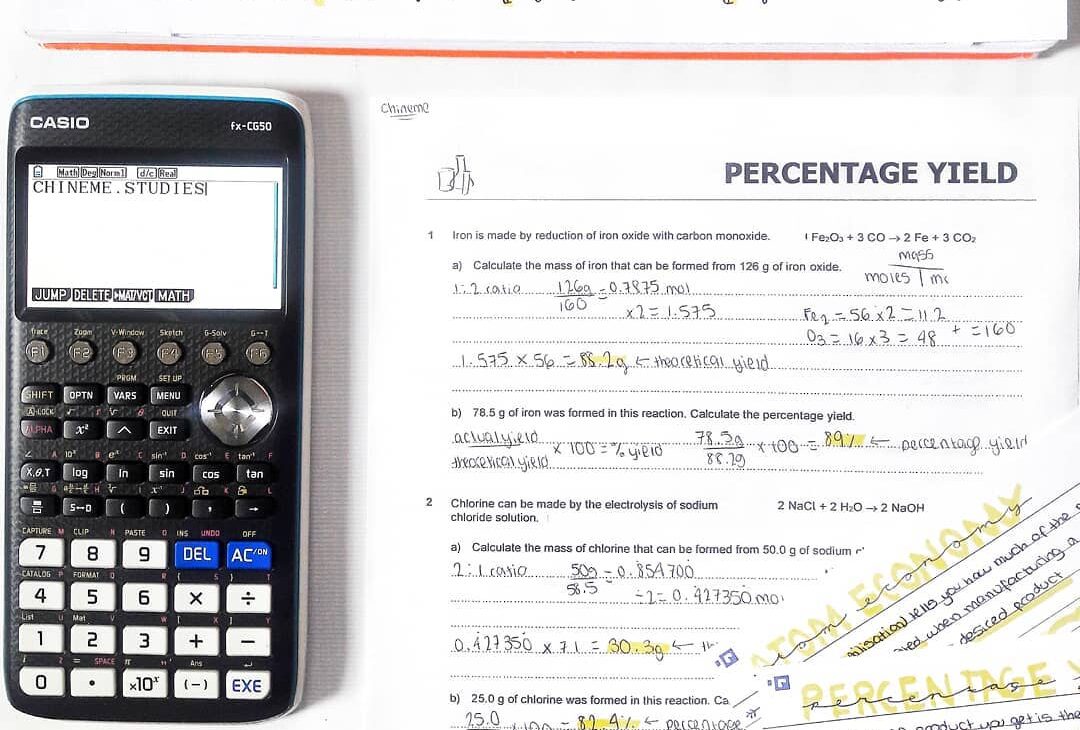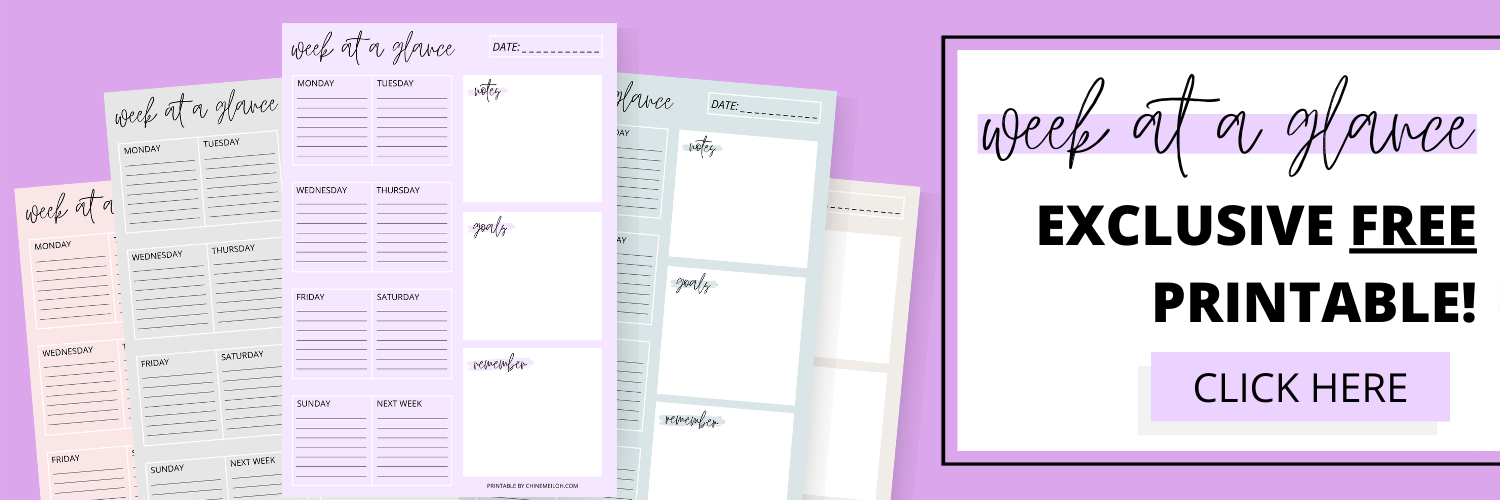If you’re a student, you’ve probably been asked to make notes from the textbook as homework or extra research. Teachers love to set that kind of work for us.
I found that courses such as the IB require a lot of independent study and note-taking, and we, therefore, have to learn how to take notes effectively by ourselves.
This is because we only ever cover so much in class. It’s a shared frustration between students when questions pop up in exams that we seemingly have never covered. This is such a common scenario that happens in practically every exam, and it just means that students just have to do a bit of learning on their own.
However, this then leaves a lot of us in a sticky situation. What do I write and what do I leave out? Could this be in the exam or is it unnecessary? This is often a dilemma we face when it comes to note-taking.
We can all relate, right? I don’t particularly like note-taking – textbooks are just huge books of small font and waffling text. Let’s be real, they’re boring. However, learning how to take notes from a textbook effectively can be a huge advantage that we can use in many areas of our lives.
I’m going to break down exactly how to take notes from a textbook in the best way possible… for everyone. Everyone has slightly different revision and note-taking methods, but hopefully, this post gives tips on note-taking that are beneficial for everyone.
This is an extensive post on how to take notes from a textbook THE RIGHT WAY. It’s going to be super helpful and exactly what you need, so keep reading!
Oh, hey! You there! Before we get any further, make sure you join my email list for news, updates, exclusive freebies and more!
![]()
(P.S. As this post is fairly long, I’ve included a table of contents so you can skip to any part you like!)
Sections In This Post
COMMON MISTAKES
There are quite a few very common mistakes that students often find themselves doing when taking notes from a textbook. It can be difficult knowing exactly what to write and what to leave out, and without enough practise, students don’t make effective notes that are going to help their learning.
Taking notes seems so simple at first, but without the right strategies in place, the notes you make are going to be completely useless.
I’ve gathered four common mistakes that we’ve all probably made (I’m guilty of one or two myself!) when taking notes from a textbook, and how to avoid them:
1. Copying from the textbook.
The first common mistake is copying everything down from the textbook. Word for word.
Yeah, I’m pretty sure that never works.
And the funny thing is, we’ve all done it! For my GCSE revision, I’d literally sit there, copying out from my revision guides almost exactly.
The problem with writing down everything (or almost everything) in the textbook chapter is you aren’t using the skill of paraphrasing the information.
>> RELATED POST: 5 Study Mistakes You're Probably Already Making
Research shows that paraphrasing information is a very effective skill because when you put it into your own words, you’re working harder to understand the content better. However, if you don’t paraphrase the material in front of you, you aren’t learning how to condense and narrow it down to just the useful facts and information.
This isn’t useful for learning or understanding the subject. Plus, it’s time-consuming. Yeah, that’s not fun.
How to avoid this mistake:
Condensing the information is very important if you want to identify what’s useful and what’s not. Often textbooks expand broadly on the info to provide a great depth of information for everyone. However, this may not always be necessary for you to include in your notes.
To save a considerable amount of time, look out for what the textbook tells you. It’s probably going to have differences in text formatting or colour or shapes to make the important facts, equations, dates, etc. stand out from the rest of the text.
For example, the textbook will say “Blah blah blah. Osmosis is the movement of water molecules across a partially permeable membrane from a region of higher water concentration to a region of lower water concentration. Blah blah blah.”
You can see that the definition of a key term is in bold, so that should definitely be going in your notes, as you’re going to need to know it. However, the “blah blah blah” parts… you probably don’t need that. This is how you can stick to the important stuff only when making your notes.
![]()
2. Ignoring important information.
Now the complete opposite scenario is just as common, and it’s the biggest mistake you can make.
Many students are either confident that they’ll immediately absorb all the content in the textbook chapter and so don’t need to take notes, or just don’t know how to take notes.
I can guarantee you, if you’re the first one, you’re probably not going to remember everything straight away, no matter how brilliantly intelligent you are.
The weakest ink is stronger than the strongest memory.
It’s so much better to play it safe and make those notes. You’ll want to review them later on, or at least have a copy of them, other than inside your brain.
If you don’t write enough, you then leave out the important information that should really be in your notes.
How to avoid this mistake:
As mentioned before, look for how the text is formatted in the textbook. These are going to stand out from the rest of the information, and it’s therefore what you should be paying extra attention to.
These are textbook cues. Look out for how the headings and subheadings are structured in order to grab an idea of what’s important and what’s not. Basically, keep an eye out for how the whole chapter is organised – they arrange the text in a certain way for a reason, so use that to your advantage.
Also, if you have an accompanying resource, such as the exam board’s specification for the subject, you can use that as a reference as to what’s actually needed in your notes and what you can leave out.
![]()
3. Skipping over the information you don’t understand.
A lot of students find themselves doing this. Often unconsciously, but nevertheless, it’s not beneficial to your learning at all.
Try not to skip over the information you read but don’t understand. There are almost always parts of the textbook chapter than will be a bit squiffy for you to absorb straight away.
How to avoid this mistake:
Read the entire textbook chapter. Doing so may give you a bit of context to what you’ve just read, and help you understand it better.
If you still don’t understand it, read it aloud. This can help your brain pick apart the sentence a bit better.
If still nothing, then seek help from other resources, such as online or a revision guide, or from other people, such as your teacher or peers. Gaining a different angle to the topic may be what you need to understand it better.
![]()
4. Over-highlighting the textbook.
The last common mistake is highlighting way more than you need in the textbook.
I’m not joking, your highlighter’s going to run out real quick if you keep playing “Colour me in” with every textbook chapter.
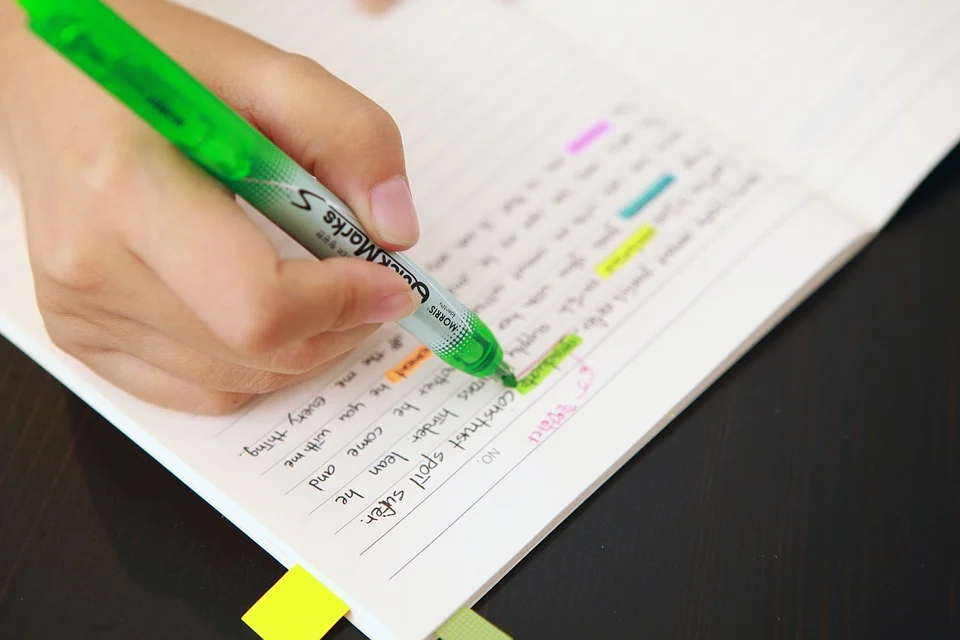
Only highlight the important parts!
I mean, it’s pretty great that you’re making an effort to identify the useful information and convert that into condensed notes, but if you highlight everything, from the necessary to the unnecessary, the aim is practically defeated.
How to avoid this mistake:
When reading your textbook chapter and highlighting information, make sure you focus on the content. Avoid getting distracted and you’ll know exactly what to pick out.
Try looking out for only the must-know information, including keywords, facts, statistics, dates etc. Everything along these lines is probably useful content.
If the textbook includes a huge analogy for understanding purposes only, you probably don’t need to highlight it.
![]()
WHERE TO START
So, you’ve got your textbook, notebook, pens and highlighters laid out in front of you. But now you don’t know exactly where to start.
I totally get it. There’s this huge, intimidating book in front of you and you have to make notes on it. It can sometimes be quite overwhelming when trying to figure out where you should begin with your task.
However, I’ve laid out the foundation of the note-taking process for you guys. Each of these steps is just as important as taking the actual notes themselves, so make sure you have all of them covered before you start writing in your notebook.
1. Determine what you need to know.
First things first, stop and think about the topic you’re currently studying. You’ve been set the task of making notes on a specific textbook chapter to take a moment to think about what you need to focus on.
It may be that you’re focusing on a specific area of the topic, in which you probably don’t need to have the entire textbook chapter in front of you.
However, you may be trying to grab the general gist of the entire module. If so, you’re probably going to need to prepare the whole chapter on that topic for your notes.
This step is important because you want to get straight to the point – you don’t want to be wasting time reading and making notes on information you know you aren’t going to need from the get-go.
You want to know what you’re looking for and what you’re going to need to include before you even start. Share on X
![]()
2. Read before you write.
The next step is to read the textbook chapter. Yep, the whole thing. Beginning to end.
Or at least what you’ve been assigned to/the topic you’re focused on.
This is important because you need to grasp a solid, general understanding of everything before you start making notes. It’s going to be useful for your work later on if your brain is already connecting the terms and concepts to one another.
Oh, and don’t just skim it, read it and understand it.
No skipping. No skimming. No cutting to the chase.
If you don’t understand something, go back to it until you do, or look it up with other resources.
Reading the chapter before making your notes is also going to help A LOT with paraphrasing – if you’ve got a general picture of the information then it’s going to be a lot easier to summarise it and put it into your own words.
Once you’ve read everything, you’ve got a general overview of the material, therefore giving an indication as to what you need and what you don’t need.
![]()
3. Highlight key points in the textbook.
Then read the chapter a second time round, but this time, only skim through it. And while you do this, highlight the key points that you think might be important for your notes.
Did I say the key points? I meant the key points ONLY.
Don’t end up colouring the entire book. Keep what you highlight to a brief and minimal amount.
Doing this exercise is a good way to identify important material, plus, it exercises your brain and works it hard to pick out the most relevant information.
I also recommend creating a highlighting colour code. For example, dates are in yellow, places are in green, key terms are in orange and definitions are in pink. A bit of organisation to your notes is going to help you out a lot when it comes to making notes in as little time possible.
![]()
4. Prepare your note-taking method.
Lastly, you should take out your notebook and prepare how you’re going to take your notes.
Skim the textbook chapter for headings and subheadings, and then use those as the main points in your notes outline.
You can prepare these headings in your notes in various ways. There are loads of different ways to take notes, but here are a few:
- Notes outline
- Sentencing method
- Mind maps
- Cornell notes
- Charting
- Using flashcards
This is the Cornell method, my personal favourite:
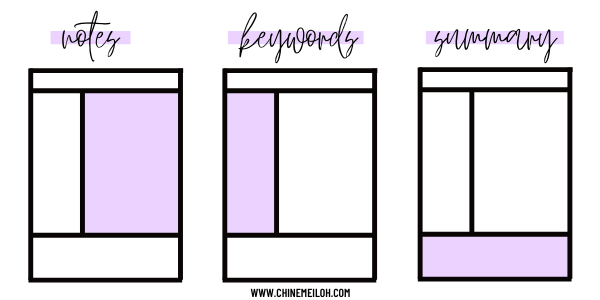
Stick to one or two of these methods that work best for you. It helps with organisation and establishes your style of learning, which you can then improve on to study more effectively.
![]()
HOW TO TAKE THE NOTES
Now we’re onto the actual note-taking process! This strategy is the core part of note-taking that you came here to see.
We’ve identified the common mistakes you need to avoid, and we’ve laid the foundation. Now we need to figure out how to actually make those notes from a textbook.
1. Read one section at a time and make your notes as you go along.
This is the exact strategy for taking the notes: read the first section in full, and then go back to your notebook and make notes on that section. Once you’ve done this, you can move onto the next section and do the same thing, and so on.
After each section, go back to your notes and fill them in.
It’s much more effective to fill your notes in as you go along with each section, rather than reading the entire chapter and making the notes all at once. If you make notes all at once, you’ll remember the information like an incomplete jigsaw puzzle and you’ll find yourself flipping back and forth through the pages, trying to find those certain facts and dates.
This wastes a lot of time and you won’t be as focused when studying.
Breaking up your note-taking into sections makes everything much easier to digest, and you’ll, therefore, be more likely to remember it all.
![]()
2. Write your notes from memory.
A catch to this method is writing your notes from memory. Here’s what you should do:
After reading the first section, close the textbook and write down the important parts that you can remember from memory.
Then check the textbook for any errors you made, the information you missed or potential improvements you could make, preferably in a different colour pen.
Working from memory is a super effective skill because it works your brain hard to recall the information you just picked up, and so you’re more likely to remember it. It’s also really hard to not paraphrase the information if you’re working from memory, which is a great thing.
Writing your notes from memory also ensures that you were paying attention and focusing on the content – this is an important advantage because the more you pay attention to what’s in front of you, the more likely you’ll remember it.
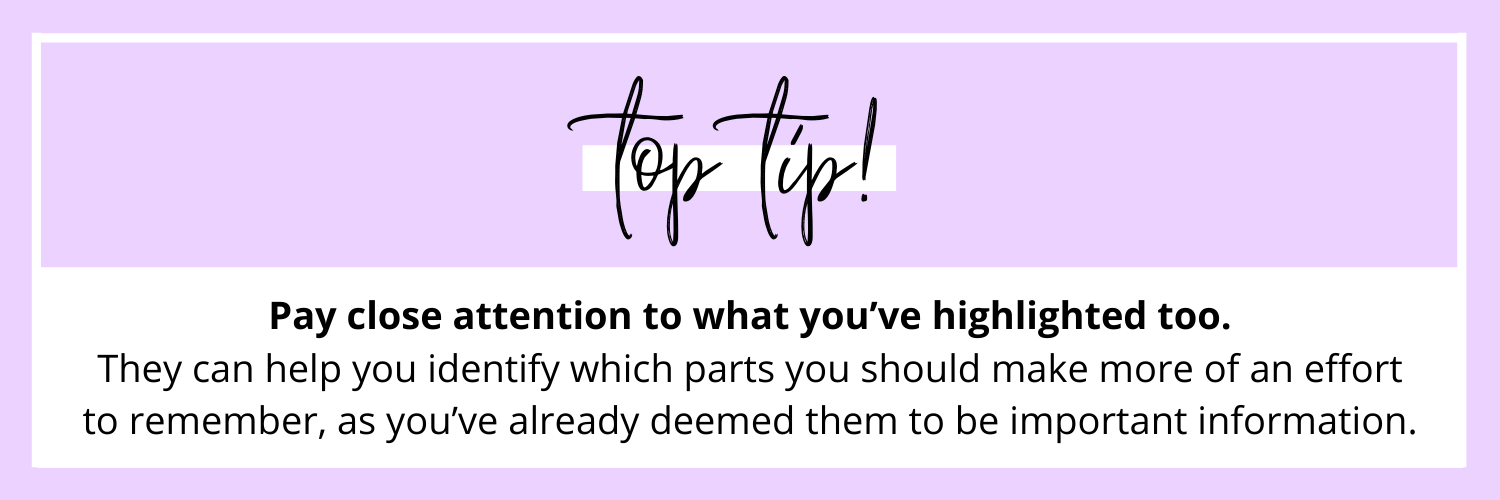
Do this method for each section after that, until you have finished the textbook chapter and you have a complete set of notes.
![]()
3. Start highlighting your notes.
Now that you have all your notes in full, read through it and use a colour code key to highlight the key parts of your notes. This is to stress the key terms, definitions, people, dates, equations etc.
When you go back to review your notes, and you need a quick refresher of the dates, for example, you’ll know that they’re all in orange highlighting.
This is a quick and easy way for you to visually organise your notes, and I highly recommend you give it a go.
![]()
4. Annotate your notes in the margins.
The next step is to add annotations. These annotations can include almost anything, such as:
- Extra information
- Connections you’ve picked up from other topics
- Your own thoughts on the topic
- Questions you may have about something you don’t understand, that you need to address with your teacher or other resources afterwards
These annotations are useful because they engage you with the topic and check your understanding. Including any queries you may have is particularly important, as it acts as a reminder to seek more clarification in the future.
You can also add a personal touch by including doodles and sticky notes – having a visual representation of your notes may help you understand the topic better.
![]()
5. Practise exam skills.
We’re getting close to the end of the process! Now, this tip is one you’re not going to hear in many places, but I’ve found it to be super useful in my note-taking process, so I highly recommend you try it.
This step is to practise some exam skills. For English, for example, near the end of my notes, I write a short, model paragraph that analyses the literature text I just covered.
Or for Economics, I’d include a critical evaluation of the topic.
And for Maths, I’d write out a full, step-by-step, worked example to help me understand it better for revision in the future, as well as a few practise questions.
Practising your exam skills is a good way to develop these skills in time for the exam. I’ve found that the facts and equations will only get you so far into the exam, and the rest of it is carried by application of knowledge.
By applying what you’ve just learnt, and marking it afterwards, you’re developing the skills needed for the exam.
![]()
6. Write a chapter summary at the end.
The very last step is to include a chapter summary at the end of your notes. I particularly love using the Cornell method because of this feature, but you can do this with any note-taking techniques you use.
The summary doesn’t have to be anything extravagant like a long-winded essay about the topic – just stick to 2 to 4 sentences that round up everything in brief, like a condensed version of everything you just covered.
If you can’t explain it simply, you don’t know it well enough.
After you complete more and more notes, you’ll accumulate a whole collection of chapter summaries that you can look at for quick reviews of the topic in the future, which is really helpful.
An alternative to this is to use sticky notes to write concise bullet points for each area of the textbook chapter.
If you stick these in the relevant areas of the textbook, you can then come back to the chapter and have a trigger for the concepts covered in it.
![]()
USEFUL TIPS TO MAKE YOUR NOTES EVEN BETTER
Now you know how to take notes in the most effective way possible – it’s a long process but it takes time and practice to get used to it and perfect it.
If you’re finding it a bit hard to use these note-taking strategies, I’ve provided a few tips to take the way you take notes from a textbook to the next level.
The foundation and structure of the process are in place – now it’s time to decorate it with a few techniques that will make your notes even better.
1. Don’t just refer to the textbook.
Something to remember is the textbook you’re using may not have all the information you possibly need on a topic.
It’s probably written by one or two people, and although the book’s been double-checked and approved by the exam board, it’s only going to have one perspective displayed in it – one way of wording the information, and one way for explaining it.
It wouldn’t be smart to rely all of your notes on just one resource. It’s important to refer to other resources for more information and ways of explaining the topic.
This can be in multiple ways. One way, which I highly recommend, as mentioned before, is using the exam board’s specification as a guide. The specification is an outline of all the facts and processes that you need to know for the exam.
When taking notes from your textbook, refer back to the specification to make sure you haven’t missed out any important details. 8 times out of 10 you’ll probably have everything you need, but it’s a good habit to double-check so that you aren’t surprised when it comes to the exam.
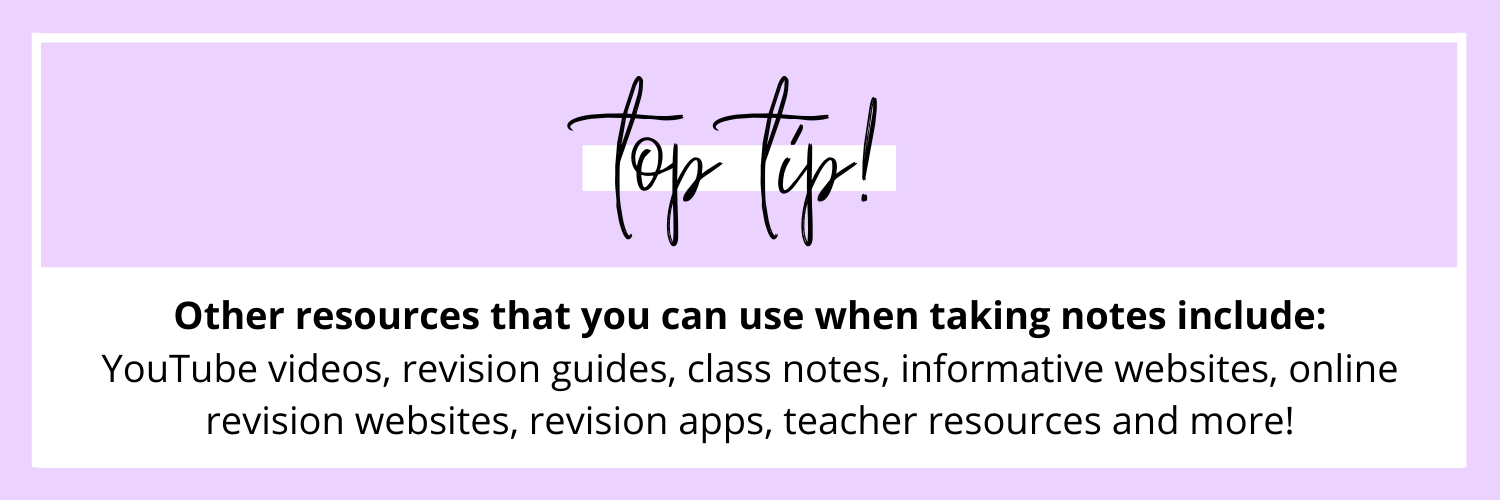
I often use revision guides more than any other resource because they’re great tools for understanding the topic a bit better – they condense the information down to the important parts and explain it in an easy-to-read way. I definitely recommend them!
You see, if you supplement your notes with other resources, you’ll have a few extra insights on the topic and you’ll develop a greater understanding of it.
![]()
2. Use the layout of the textbook to organise your notes.
I mentioned this briefly before, but the format of the textbook is a great way to figure out how to organise your notes.
The textbook is laid out in a certain way for a reason. Those bold pieces of text that are significantly bigger than the rest of the text are headings and subheadings, and you should use those to identify the main points for your notes.
The headings and subheadings act as the backbone for your notes, so use them to your advantage.
In addition, use bold and italic text in the textbook to pick out the important parts, and make them stand out in your notes. This is useful for when you’re looking back on your notes – you’ll want to be able to see the key terms and facts straight away.
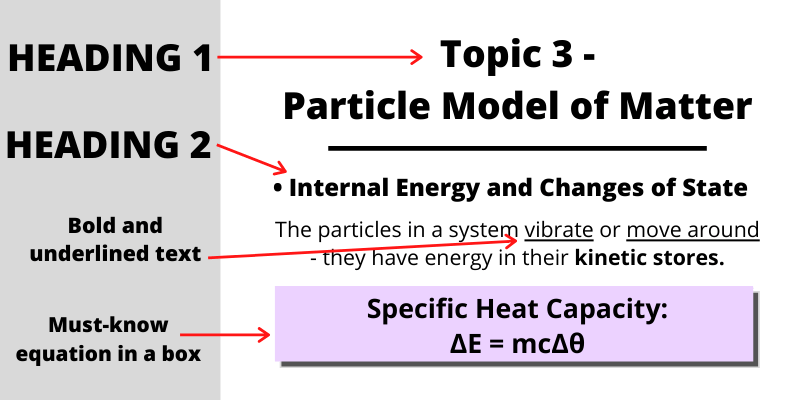
![]()
3. Display the information in different ways.
Visual differences in how you display the information in your notes are great ways to help you understand the topic a bit better.
If you’re doing a notes outline, this can be with bullet points, arrows and shortcut sentences. However, you can also use:
- Flow charts to outline processes
- Mind maps to display ideas around a key theme
- Graphs to graphically display a formula
- Post-it notes for extra information
- Diagrams to visually display how something works
Adding a few graphics to your notes help certain things stand out more. It’s not fun to just write pages and pages of information, so spice it up a bit.
It’s also better for memorisation of the topic if you can visualise how things work. That’s why if you include graphics, especially diagrams, don’t be afraid to colour them in either!
![]()
4. Use abbreviations and acronyms.
If you want to take your notes in the fastest, most efficient way possible, I definitely suggest you use abbreviations and acronyms in your notes.
The information in textbooks are long-winded and detailed – it’s mainly like this so that everyone using it can understand the content. However, the notes you make are for yourself alone – you don’t need to make them long-winded for everyone to understand when you’re probably the only one who’s going to use them.
To make more valuable notes in a shorter amount of time, use abbreviations and acronyms. Abbreviations include signs and symbols, such ∵ as for ‘therefore’, or Dr. for ‘doctor’. Acronyms could include shortened phrases, like CPM for conservative plate margins.
It’s clear that using abbreviations and acronyms can significantly speed up the note-taking process.
You can even create a key at the start/end of your notes, showing all the acronyms you included. This is useful for when you review your notes in the future and you possibly forget what one of the acronyms mean.
![]()
5. Write the date and topic you’re taking notes from.
This tip is mainly for organisation purposes. If you write the topic that you’re making notes on and the date you’re doing it, in the corner of your notebook, you can organise all of your notes in order of when they were made and together with like topics.
This is a useful habit to get into because it makes your notes easy to navigate and therefore easy to revise from.
Many courses, such as A-levels or the IB, a studied over a long period of time, such as two or three years. You’ll want to be organised from the start so that when the exams come around in Year 2, you can still find and revise from the notes you made in Year 1.
You should also make a note of the relevant page numbers in the textbook that you made notes from, just in case you need to return to the textbook pages you made the notes on at a later date.
![]()
6. Don’t use a laptop.
Yes, I said it. When making your notes from a textbook, I meant handwritten notes the whole way through.
And I still mean it.
This applies to computers and iPads too – anything you can type on is a no-no.
Typing notes just isn’t as effective as handwritten notes. I mean, yes, it’s true, it’s much faster to type your notes. But it’s not efficient, and here’s why:
Writing your notes by hand generally helps you understand the topic more. You’re more inclined to paraphrase and put the information in your own words, as handwriting involves your brain processing the information a lot deeper.
However, if you write your notes on a computer, your brain isn’t going to have enough time to process the information, due to it being a much faster method, and so you’re probably going to copy a lot of the content down.
It’s great to cut down on time and take notes in as little time as possible, but you’ve got to make sure you’re doing it efficiently too.
7. Review your notes.
You’ve probably noticed by now that I’ve mentioned reviewing your notes about a gazillion times, and now I’m going to say it once more.
If you figure out a reviewing schedule to consistently come back to those notes you made and revise them, you’re going to improve your memory and understanding of the topic by a long shot.
It’s been proven over and over that students who review their notes every now and then perform much better in exams and assessments than those who don’t.
Reviewing your notes also helps you to avoid last-minute cramming before exams, which is not something you want to be doing.
You can literally review your notes for 15 minutes each day, and you’ll have the perfect memory of the topic in no time. This will have a massive impact on your studies, so make sure you adopt this habit as soon as possible!
>> RELATED POST: 5 Easy Ways To Improve Your Study Habits
![]()
8. Practise taking notes.
The important thing to remember from all of this is that it takes practice. You aren’t going to be an expert at taking notes from the beginning – you need to practise and improve your methods to get better at it.
I must admit, taking notes most effectively is definitely hard at first, but it does get easier as you get better. It seems to be a long process at first, but it’ll be faster and more efficient the more you practise.
Practice makes perfect!
And the best thing about practising this method time and time again is that you can soon identify what works for you and what doesn’t, and then you can tailor these strategies to your liking.
Once you’ve done this, you’ll be left with the ultimate note-taking method that works every time and leaves your teachers, peers and examiners in awe of your extensive knowledge.
You’ll get there. It takes time, but it’s all worth it, you’ll see!
![]()
YOUR TAKEAWAY
And… relax! That’s the whole lot – that’s the full blog post on how to take notes from a textbook the right way!
This strategy may seem to be a long process and it may seem like there’s a lot to remember when taking notes. I know. However, it really is worth the time investment.
As I mentioned before, the more you practise it, the better you’ll become at taking notes from a textbook effectively.
I included a lot on information and advice in this post, so below are the main points, but make sure you scroll to the table of contents at the top of the post if you need a quick refresher of everything I covered!
- COMMON MISTAKES
- WHERE TO START
- HOW TO TAKE NOTES
- USEFUL TIPS
Ahh, I really enjoyed writing this! I learnt quite a lot too, and some of these strategies I wasn’t even utilising properly myself, so I’m definitely going to make an effort to change those.
However, I really do hope you found this useful and informative, even though it’s probably as long as a university dissertation!
If you enjoyed this post, you might also enjoy some of these posts too!:
- 5 Study Mistakes You’re Probably Already Making: Here’s How To Avoid Them
- “Study Smarter, Not Harder”: 13 Tips On How To Study Effectively
- 5 Easy Ways To Improve Your Study Habits
If you have any comments, questions or contributions, please feel free to comment them down below! I’m always checking and responding to comments!
Thanks for reading and have fun note-taking!
Chat soon,

![]()

